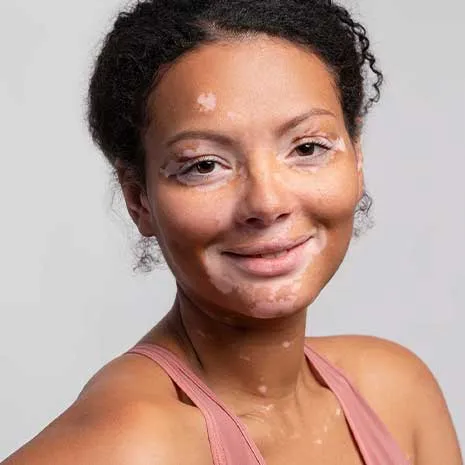How Should Skin Care Be for Vitiligo Patients?

How Should Skin Care Be for Vitiligo Patients?
- 31 July 2025
- 148

Vitiligo is a chronic autoimmune skin disorder characterized by the destruction of melanocytes, the pigment-producing cells in the skin. This leads to well-defined white patches (depigmentation), primarily on sun-exposed or high-friction areas. While the condition is not contagious or life-threatening, it alters the skin’s physiology, rendering it more sensitive to UV rays, environmental pollutants, and irritants.
As a result, vitiligo patients require a highly specialized skincare routine—one that protects, hydrates, and supports the skin while minimizing inflammation and further pigment loss. This article presents a comprehensive skin care guide based on dermatological best practices, scientific evidence, and real-world experience.
How Does Vitiligo Affect the Skin?
Melanin plays a crucial role in protecting the skin against UV radiation, maintaining moisture, and supporting the immune barrier. In vitiligo-affected skin, the absence of melanin causes:
- Increased sensitivity to sunlight (UV damage risk)
- Dehydrated, fragile skin barrier
- Heightened susceptibility to irritation and inflammation
- Altered skin microbiome and immune balance
Understanding these changes is the first step to designing a proper skincare routine tailored for vitiligo.
Daily Skin Cleansing and Moisturizing Routine
A consistent, gentle daily skincare regimen is essential for maintaining skin health in vitiligo patients.
1. Cleansing
- Use soap-free, pH-balanced cleansers
- Avoid products with alcohol, sulfates (SLS), synthetic fragrances, or harsh exfoliants
- Choose cleansers that preserve the natural skin microbiota and reduce trans-epidermal water loss
2. Moisturizing
- Opt for moisturizers containing ceramides, hyaluronic acid, glycerin, or panthenol
- Use lighter moisturizers in summer, and richer, barrier-repairing creams in winter
- Apply moisturizers twice daily to prevent dryness and cracking
3. Exfoliation
- Avoid mechanical exfoliants (scrubs, brushes) which may cause micro-injuries and trigger new lesions (Koebner phenomenon)
- Mild chemical exfoliants (like lactic acid or polyhydroxy acids) can be used once weekly, but only with medical supervision
- Over-exfoliating can compromise the skin barrier and worsen sensitivity
Sun Protection: The Most Crucial Step
Sunlight can worsen vitiligo by making depigmented areas more noticeable and increasing the risk of sunburn and oxidative damage. Since melanin offers natural UV protection, vitiligo-affected skin is especially vulnerable.
1. Sunscreen Application
- Use broad-spectrum SPF 50+ sunscreen daily, regardless of weather
- Reapply every 2–3 hours, especially during outdoor activities
- Choose sunscreens with zinc oxide, titanium dioxide, or antioxidant ingredients
- Tinted sunscreens may help mask uneven pigmentation while offering coverage
2. Sun-Protective Clothing
- Wear wide-brimmed hats, UV-filtered sunglasses, and long-sleeve cotton clothing
- UPF-rated fabrics offer enhanced protection for outdoor settings
- Children and individuals with facial vitiligo should take extra precautions
3. Managing Sunburn
- Apply cool compresses, aloe vera gel, and fragrance-free moisturizers
- Avoid direct sun exposure for several days after a sunburn
- Consult a dermatologist if the burn is severe
Cosmetic Camouflage and Makeup Tips
Cosmetic products can help vitiligo patients feel more confident and improve quality of life.
- Choose hypoallergenic, dermatologically tested camouflage creams
- Use color-correcting makeup (e.g., orange correctors for blue-toned patches)
- Select water-resistant, long-wearing formulas for better coverage and durability
- Always patch test before using a new product to avoid allergic reactions
Seasonal Skincare Considerations
Different seasons bring different skin care challenges. Vitiligo patients should adjust their routine accordingly.
In Summer:
- Increase sunscreen use and reapplication
- Opt for lightweight gel moisturizers
- Take extra precautions during swimming or sunbathing
- Rinse the skin thoroughly after saltwater or chlorine exposure
In Winter:
- Use richer moisturizers with ceramides and shea butter
- Avoid long, hot showers that strip the skin barrier
- Humidify indoor air to prevent excessive skin dryness
- Dress in layers to protect against windburn and cold-induced irritation
Natural Remedies and Plant-Based Support
While some natural ingredients may provide supportive skin benefits, vitiligo patients should be cautious:
- Aloe vera, jojoba oil, zinc oxide creams may soothe irritation and improve hydration
- Avoid DIY mixtures with unknown or hormone-altering compounds
- Always test new products on a small area and consult your dermatologist before use
- Claims of miracle “cures” from unregulated herbal mixtures should be treated with skepticism
Nutritional Support for Healthy Skin
What you eat also affects your skin. Several nutrients are known to support immune balance and skin regeneration.
- Focus on anti-inflammatory foods: green vegetables, berries, omega-3 fatty acids
- Ensure adequate intake of vitamin D, B12, folic acid, zinc, and copper
- Stay well-hydrated—drink 1.5 to 2 liters of water per day
- Avoid excessive sugar, alcohol, and processed foods, which may worsen inflammation
Some studies suggest that antioxidant supplementation may help reduce oxidative stress in vitiligo, but results vary individually.
Professional Dermatological Guidance
Each patient’s skin is unique. Vitiligo skincare should be tailored to individual needs through expert assessment:
- Get a dermatological evaluation every 6–12 months
- Adjust skincare based on skin type (dry, oily, sensitive), age, and disease severity
- During pregnancy, lactation, or concurrent illness, revise your regimen with medical supervision
- Avoid unnecessary skincare “trends” and stick with proven, science-backed methods
Frequently Asked Questions
Yes. Due to the lack of melanin, vitiligo skin is more prone to UV damage, dryness, and irritation.
Yes, but it’s best to use fragrance-free, ceramide-rich formulations specifically designed for sensitive skin.
Yes. Indoor lighting and incidental sun exposure (e.g., near windows) still contribute to UV stress.
Yes, as long as products are non-comedogenic, hypoallergenic, and free from irritants.
Some may offer minor benefits, but none are curative. Use them only under medical guidance.
